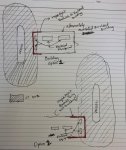D!NNy
Senior Member
- Location
- San Luis Obispo
My project has a couple of VFDs that are located in the C1D2 area as shown in the picture.
we want to explore all the options available to get these drives rated to be operated in the C1D2 area:
i. Moving the drives out of c1d2 is not possible
ii. Installing a purge system is not possible for the size drives we have (500kVA, 600kVA and 1200kVA toshiba drives)
iii. installing a new building around these drives. I am evaluating two options.
Option 1: Installing a enclosed building, adequately ventilated and move drives into it. And make sure building is vapor tight for the C1D2 radius only.
Option 2: Install a barrier vaportight similar to option 1 but it is not an enclosed building.
My question is as per API 500 provided a building adequately ventilated and vapor tight portion is a straight forward solution (option 1) , but instead of placing a enclosed building, why not put a barrier that is vapour tight for the C1D2 area (option 2) which is cheaper and easy to build?
How a adequately ventilated building is different to have a barrier ? see attached picture.
Thanks for the help in advance.
we want to explore all the options available to get these drives rated to be operated in the C1D2 area:
i. Moving the drives out of c1d2 is not possible
ii. Installing a purge system is not possible for the size drives we have (500kVA, 600kVA and 1200kVA toshiba drives)
iii. installing a new building around these drives. I am evaluating two options.
Option 1: Installing a enclosed building, adequately ventilated and move drives into it. And make sure building is vapor tight for the C1D2 radius only.
Option 2: Install a barrier vaportight similar to option 1 but it is not an enclosed building.
My question is as per API 500 provided a building adequately ventilated and vapor tight portion is a straight forward solution (option 1) , but instead of placing a enclosed building, why not put a barrier that is vapour tight for the C1D2 area (option 2) which is cheaper and easy to build?
How a adequately ventilated building is different to have a barrier ? see attached picture.
Thanks for the help in advance.

